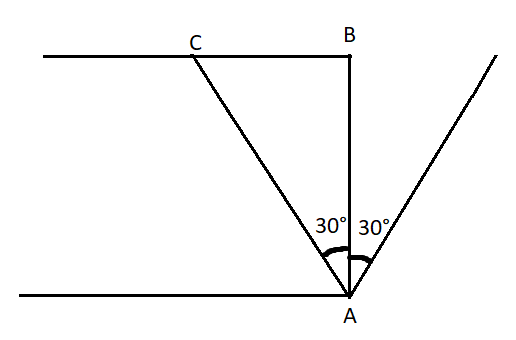
Two parallel plane mirrors ${M_1}$and ${M_2}$ have a length of $2m$ each and are $20mm$ apart. A ray of light is incident on one end of the mirror ${M_2}$ at an angle ${30^ \circ }$. The number of reflection, the light ray undergoes before it reaches the other one would be

$\Delta ABC\tan {30^ \circ } = \dfrac{{BC}}{{AB}}$
$BC = 20mm\tan {30^ \circ }$
$l = N \times BC$
(A) $173$
(B) $84$
(C) $346$
(D) $42$
Answer
174k+ views
HintThe reflection of the mirror causes the deviation of the incident ray. Here we have two mirrors kept in parallel. For the incident ray falling at one end of one of the parallel mirrors will be deviated due to the reflection of the mirror. This will continue until it reaches the other end.
Step by step solution
The angle of incidence is given as ${30^ \circ }$
The separation between the mirrors is given as $20mm = 2cm$
By applying trigonometry,
The distance travelled by the ray to deviate from the normal in each reflection to reach the other end can be written as: $BC = 2 \times \tan {30^ \circ } = 1.1547cm$
Let us assume that the number of reflections is $N$
The total deviation that the incident ray underwent from the point of incidence can be written as: $1.1547N$
The length of the mirror is given by $2m = 200cm$
The length of the mirror is $l = N \times BC$
From this, we can write the number of reflections as,
$N = \dfrac{l}{{BC}}$
Substituting the values we get
$N = \dfrac{{200}}{{1.1547}} = 173.310$
The answer is Option (A): $173$
Note
As $0.310 \times 1.1547 = 0.3577 < 1.1547$ so it cannot be taken as one full reflection hence we can neglect the decimal part. The angle between the ray of incidence and the normal is called the angle of incidence. The angle between the ray of reflection and the normal is called the angle of reflection. The images produced by real objects in the plane mirrors are always virtual and the images produced by virtual objects are always real. Plane mirrors have an infinite focal length. The optical power of a plane will be zero. In plane mirrors the images will be laterally inverted.
Step by step solution
The angle of incidence is given as ${30^ \circ }$
The separation between the mirrors is given as $20mm = 2cm$
By applying trigonometry,
The distance travelled by the ray to deviate from the normal in each reflection to reach the other end can be written as: $BC = 2 \times \tan {30^ \circ } = 1.1547cm$
Let us assume that the number of reflections is $N$
The total deviation that the incident ray underwent from the point of incidence can be written as: $1.1547N$
The length of the mirror is given by $2m = 200cm$
The length of the mirror is $l = N \times BC$
From this, we can write the number of reflections as,
$N = \dfrac{l}{{BC}}$
Substituting the values we get
$N = \dfrac{{200}}{{1.1547}} = 173.310$
The answer is Option (A): $173$
Note
As $0.310 \times 1.1547 = 0.3577 < 1.1547$ so it cannot be taken as one full reflection hence we can neglect the decimal part. The angle between the ray of incidence and the normal is called the angle of incidence. The angle between the ray of reflection and the normal is called the angle of reflection. The images produced by real objects in the plane mirrors are always virtual and the images produced by virtual objects are always real. Plane mirrors have an infinite focal length. The optical power of a plane will be zero. In plane mirrors the images will be laterally inverted.
Recently Updated Pages
JEE Main 2025-26 Atoms and Nuclei Mock Test: Free Practice Online

JEE Main 2025-26: Dual Nature of Matter and Radiation Mock Test

JEE Main 2025-26 Electronic Devices Mock Test – Free Practice

JEE Main Mock Test 2025-26: Experimental Skills Chapter Online Practice

JEE Main 2025-26 Current Electricity Mock Test: Free Practice Online

JEE Main 2025-26 Rotational Motion Mock Test – Free Practice Online

Trending doubts
JEE Main 2025 Session 2: Application Form (Out), Exam Dates (Released), Eligibility, & More

Displacement-Time Graph and Velocity-Time Graph for JEE

Uniform Acceleration

Electric field due to uniformly charged sphere class 12 physics JEE_Main

JEE Main 2025: Derivation of Equation of Trajectory in Physics

Learn About Angle Of Deviation In Prism: JEE Main Physics 2025

Other Pages
JEE Advanced Marks vs Ranks 2025: Understanding Category-wise Qualifying Marks and Previous Year Cut-offs

Instantaneous Velocity - Formula based Examples for JEE

JEE Advanced Weightage 2025 Chapter-Wise for Physics, Maths and Chemistry

Essential Derivations for CBSE Class 12 Physics: Stepwise & PDF Solutions

Electron Gain Enthalpy and Electron Affinity for JEE

Wheatstone Bridge for JEE Main Physics 2025




